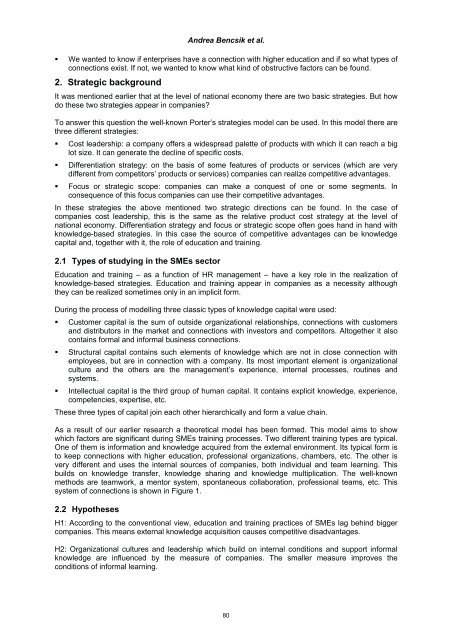Proceedings of the 3rd European Conference on Intellectual Capital
Proceedings of the 3rd European Conference on Intellectual Capital
Proceedings of the 3rd European Conference on Intellectual Capital
Create successful ePaper yourself
Turn your PDF publications into a flip-book with our unique Google optimized e-Paper software.
Andrea Bencsik et al.<br />
We wanted to know if enterprises have a c<strong>on</strong>necti<strong>on</strong> with higher educati<strong>on</strong> and if so what types <str<strong>on</strong>g>of</str<strong>on</strong>g><br />
c<strong>on</strong>necti<strong>on</strong>s exist. If not, we wanted to know what kind <str<strong>on</strong>g>of</str<strong>on</strong>g> obstructive factors can be found.<br />
2. Strategic background<br />
It was menti<strong>on</strong>ed earlier that at <str<strong>on</strong>g>the</str<strong>on</strong>g> level <str<strong>on</strong>g>of</str<strong>on</strong>g> nati<strong>on</strong>al ec<strong>on</strong>omy <str<strong>on</strong>g>the</str<strong>on</strong>g>re are two basic strategies. But how<br />
do <str<strong>on</strong>g>the</str<strong>on</strong>g>se two strategies appear in companies?<br />
To answer this questi<strong>on</strong> <str<strong>on</strong>g>the</str<strong>on</strong>g> well-known Porter’s strategies model can be used. In this model <str<strong>on</strong>g>the</str<strong>on</strong>g>re are<br />
three different strategies:<br />
Cost leadership: a company <str<strong>on</strong>g>of</str<strong>on</strong>g>fers a widespread palette <str<strong>on</strong>g>of</str<strong>on</strong>g> products with which it can reach a big<br />
lot size. It can generate <str<strong>on</strong>g>the</str<strong>on</strong>g> decline <str<strong>on</strong>g>of</str<strong>on</strong>g> specific costs.<br />
Differentiati<strong>on</strong> strategy: <strong>on</strong> <str<strong>on</strong>g>the</str<strong>on</strong>g> basis <str<strong>on</strong>g>of</str<strong>on</strong>g> some features <str<strong>on</strong>g>of</str<strong>on</strong>g> products or services (which are very<br />
different from competitors’ products or services) companies can realize competitive advantages.<br />
Focus or strategic scope: companies can make a c<strong>on</strong>quest <str<strong>on</strong>g>of</str<strong>on</strong>g> <strong>on</strong>e or some segments. In<br />
c<strong>on</strong>sequence <str<strong>on</strong>g>of</str<strong>on</strong>g> this focus companies can use <str<strong>on</strong>g>the</str<strong>on</strong>g>ir competitive advantages.<br />
In <str<strong>on</strong>g>the</str<strong>on</strong>g>se strategies <str<strong>on</strong>g>the</str<strong>on</strong>g> above menti<strong>on</strong>ed two strategic directi<strong>on</strong>s can be found. In <str<strong>on</strong>g>the</str<strong>on</strong>g> case <str<strong>on</strong>g>of</str<strong>on</strong>g><br />
companies cost leadership, this is <str<strong>on</strong>g>the</str<strong>on</strong>g> same as <str<strong>on</strong>g>the</str<strong>on</strong>g> relative product cost strategy at <str<strong>on</strong>g>the</str<strong>on</strong>g> level <str<strong>on</strong>g>of</str<strong>on</strong>g><br />
nati<strong>on</strong>al ec<strong>on</strong>omy. Differentiati<strong>on</strong> strategy and focus or strategic scope <str<strong>on</strong>g>of</str<strong>on</strong>g>ten goes hand in hand with<br />
knowledge-based strategies. In this case <str<strong>on</strong>g>the</str<strong>on</strong>g> source <str<strong>on</strong>g>of</str<strong>on</strong>g> competitive advantages can be knowledge<br />
capital and, toge<str<strong>on</strong>g>the</str<strong>on</strong>g>r with it, <str<strong>on</strong>g>the</str<strong>on</strong>g> role <str<strong>on</strong>g>of</str<strong>on</strong>g> educati<strong>on</strong> and training.<br />
2.1 Types <str<strong>on</strong>g>of</str<strong>on</strong>g> studying in <str<strong>on</strong>g>the</str<strong>on</strong>g> SMEs sector<br />
Educati<strong>on</strong> and training – as a functi<strong>on</strong> <str<strong>on</strong>g>of</str<strong>on</strong>g> HR management – have a key role in <str<strong>on</strong>g>the</str<strong>on</strong>g> realizati<strong>on</strong> <str<strong>on</strong>g>of</str<strong>on</strong>g><br />
knowledge-based strategies. Educati<strong>on</strong> and training appear in companies as a necessity although<br />
<str<strong>on</strong>g>the</str<strong>on</strong>g>y can be realized sometimes <strong>on</strong>ly in an implicit form.<br />
During <str<strong>on</strong>g>the</str<strong>on</strong>g> process <str<strong>on</strong>g>of</str<strong>on</strong>g> modelling three classic types <str<strong>on</strong>g>of</str<strong>on</strong>g> knowledge capital were used:<br />
Customer capital is <str<strong>on</strong>g>the</str<strong>on</strong>g> sum <str<strong>on</strong>g>of</str<strong>on</strong>g> outside organizati<strong>on</strong>al relati<strong>on</strong>ships, c<strong>on</strong>necti<strong>on</strong>s with customers<br />
and distributors in <str<strong>on</strong>g>the</str<strong>on</strong>g> market and c<strong>on</strong>necti<strong>on</strong>s with investors and competitors. Altoge<str<strong>on</strong>g>the</str<strong>on</strong>g>r it also<br />
c<strong>on</strong>tains formal and informal business c<strong>on</strong>necti<strong>on</strong>s.<br />
Structural capital c<strong>on</strong>tains such elements <str<strong>on</strong>g>of</str<strong>on</strong>g> knowledge which are not in close c<strong>on</strong>necti<strong>on</strong> with<br />
employees, but are in c<strong>on</strong>necti<strong>on</strong> with a company. Its most important element is organizati<strong>on</strong>al<br />
culture and <str<strong>on</strong>g>the</str<strong>on</strong>g> o<str<strong>on</strong>g>the</str<strong>on</strong>g>rs are <str<strong>on</strong>g>the</str<strong>on</strong>g> management’s experience, internal processes, routines and<br />
systems.<br />
<strong>Intellectual</strong> capital is <str<strong>on</strong>g>the</str<strong>on</strong>g> third group <str<strong>on</strong>g>of</str<strong>on</strong>g> human capital. It c<strong>on</strong>tains explicit knowledge, experience,<br />
competencies, expertise, etc.<br />
These three types <str<strong>on</strong>g>of</str<strong>on</strong>g> capital join each o<str<strong>on</strong>g>the</str<strong>on</strong>g>r hierarchically and form a value chain.<br />
As a result <str<strong>on</strong>g>of</str<strong>on</strong>g> our earlier research a <str<strong>on</strong>g>the</str<strong>on</strong>g>oretical model has been formed. This model aims to show<br />
which factors are significant during SMEs training processes. Two different training types are typical.<br />
One <str<strong>on</strong>g>of</str<strong>on</strong>g> <str<strong>on</strong>g>the</str<strong>on</strong>g>m is informati<strong>on</strong> and knowledge acquired from <str<strong>on</strong>g>the</str<strong>on</strong>g> external envir<strong>on</strong>ment. Its typical form is<br />
to keep c<strong>on</strong>necti<strong>on</strong>s with higher educati<strong>on</strong>, pr<str<strong>on</strong>g>of</str<strong>on</strong>g>essi<strong>on</strong>al organizati<strong>on</strong>s, chambers, etc. The o<str<strong>on</strong>g>the</str<strong>on</strong>g>r is<br />
very different and uses <str<strong>on</strong>g>the</str<strong>on</strong>g> internal sources <str<strong>on</strong>g>of</str<strong>on</strong>g> companies, both individual and team learning. This<br />
builds <strong>on</strong> knowledge transfer, knowledge sharing and knowledge multiplicati<strong>on</strong>. The well-known<br />
methods are teamwork, a mentor system, sp<strong>on</strong>taneous collaborati<strong>on</strong>, pr<str<strong>on</strong>g>of</str<strong>on</strong>g>essi<strong>on</strong>al teams, etc. This<br />
system <str<strong>on</strong>g>of</str<strong>on</strong>g> c<strong>on</strong>necti<strong>on</strong>s is shown in Figure 1.<br />
2.2 Hypo<str<strong>on</strong>g>the</str<strong>on</strong>g>ses<br />
H1: According to <str<strong>on</strong>g>the</str<strong>on</strong>g> c<strong>on</strong>venti<strong>on</strong>al view, educati<strong>on</strong> and training practices <str<strong>on</strong>g>of</str<strong>on</strong>g> SMEs lag behind bigger<br />
companies. This means external knowledge acquisiti<strong>on</strong> causes competitive disadvantages.<br />
H2: Organizati<strong>on</strong>al cultures and leadership which build <strong>on</strong> internal c<strong>on</strong>diti<strong>on</strong>s and support informal<br />
knowledge are influenced by <str<strong>on</strong>g>the</str<strong>on</strong>g> measure <str<strong>on</strong>g>of</str<strong>on</strong>g> companies. The smaller measure improves <str<strong>on</strong>g>the</str<strong>on</strong>g><br />
c<strong>on</strong>diti<strong>on</strong>s <str<strong>on</strong>g>of</str<strong>on</strong>g> informal learning.<br />
80
















